wheel FIAT DOBLO COMBI 2010 Owner handbook (in English)
[x] Cancel search | Manufacturer: FIAT, Model Year: 2010, Model line: DOBLO COMBI, Model: FIAT DOBLO COMBI 2010Pages: 274, PDF Size: 6.16 MB
Page 172 of 274
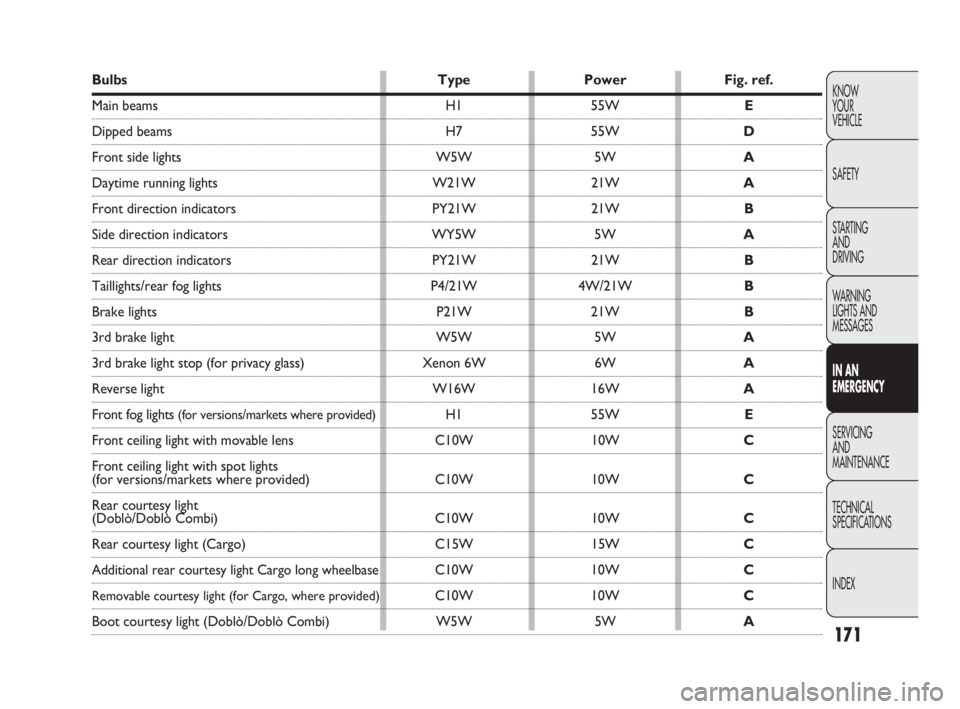
171
KNOW
YOUR
VEHICLE
SAFETY
STARTING
AND
DRIVING
WARNING
LIGHTS AND
MESSAGES
IN AN
EMERGENCY
SERVICING
AND
MAINTENANCE
TECHNICAL
SPECIFICATIONS
INDEX
Bulbs Type Power Fig. ref.
Main beams H1 55W E
Dipped beams H7 55WD
Front side lights W5W 5WA
Daytime running lights W21W 21WA
Front direction indicators PY21W 21WB
Side direction indicators WY5W 5WA
Rear direction indicators PY21W 21WB
Taillights/rear fog lights P4/21W 4W/21WB
Brake lights P21W 21WB
3rd brake light W5W 5WA
3rd brake light stop (for privacy glass) Xenon 6W 6WA
Reverse light W16W 16WA
Front fog lights (for versions/markets where provided)H1 55WE
Front ceiling light with movable lens C10W 10WC
Front ceiling light with spot lights
(for versions/markets where provided) C10W 10WC
Rear courtesy light
(Doblò/Doblò Combi) C10W 10WC
Rear courtesy light (Cargo) C15W 15WC
Additional rear courtesy light Cargo long wheelbaseC10W 10WC
Removable courtesy light (for Cargo, where provided)C10W 10WC
Boot courtesy light (Doblò/Doblò Combi) W5W 5WA
155-190 DOBLO LUM EN 2e 7.0 21-05-2010 11:34 Pagina 171
Page 191 of 274
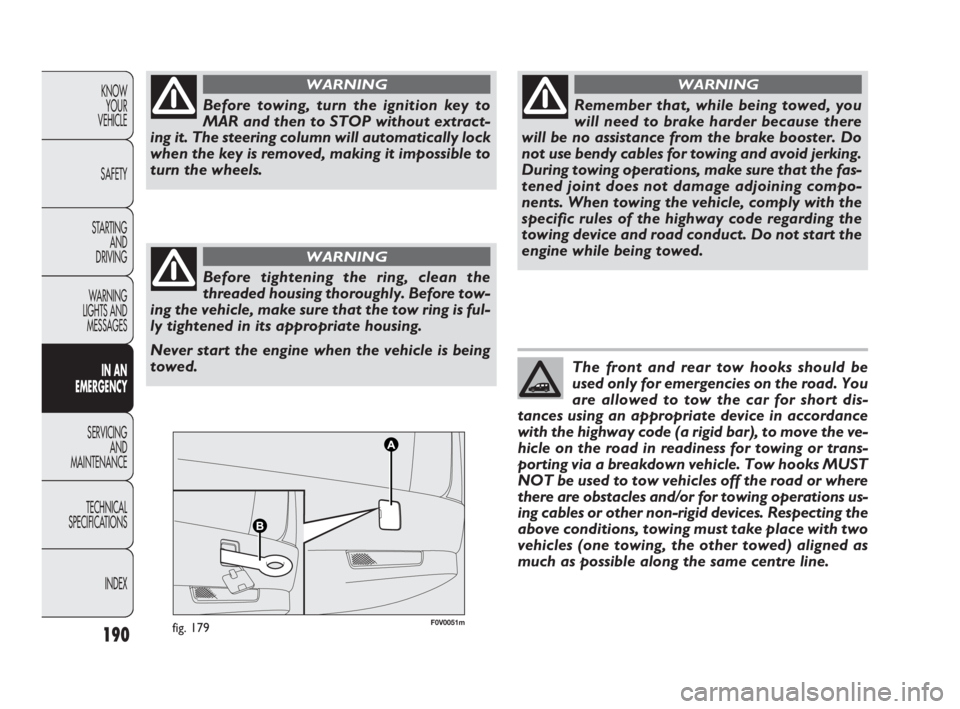
190
KNOW
YOUR
VEHICLE
SAFETY
STARTING
AND
DRIVING
WARNING
LIGHTS AND
MESSAGES
IN AN
EMERGENCY
SERVICING
AND
MAINTENANCE
TECHNICAL
SPECIFICATIONS
INDEX
F0V0051mfig. 179
Before towing, turn the ignition key to
MAR and then to STOP without extract-
ing it. The steering column will automatically lock
when the key is removed, making it impossible to
turn the wheels.
WARNING
Before tightening the ring, clean the
threaded housing thoroughly. Before tow-
ing the vehicle, make sure that the tow ring is ful-
ly tightened in its appropriate housing.
Never start the engine when the vehicle is being
towed.
WARNING
Remember that, while being towed, you
will need to brake harder because there
will be no assistance from the brake booster. Do
not use bendy cables for towing and avoid jerking.
During towing operations, make sure that the fas-
tened joint does not damage adjoining compo-
nents. When towing the vehicle, comply with the
specific rules of the highway code regarding the
towing device and road conduct. Do not start the
engine while being towed.
WARNING
The front and rear tow hooks should be
used only for emergencies on the road. You
are allowed to tow the car for short dis-
tances using an appropriate device in accordance
with the highway code (a rigid bar), to move the ve-
hicle on the road in readiness for towing or trans-
porting via a breakdown vehicle. Tow hooks MUST
NOT be used to tow vehicles off the road or where
there are obstacles and/or for towing operations us-
ing cables or other non-rigid devices. Respecting the
above conditions, towing must take place with two
vehicles (one towing, the other towed) aligned as
much as possible along the same centre line.
155-190 DOBLO LUM EN 2e 7.0 21-05-2010 11:34 Pagina 190
Page 210 of 274
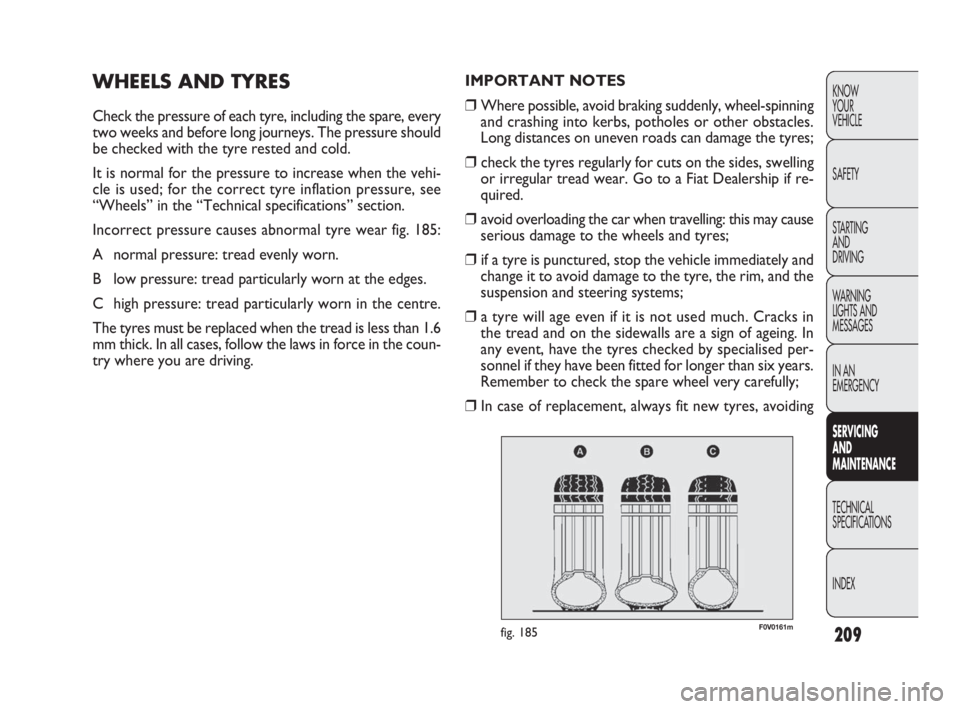
209
KNOW
YOUR
VEHICLE
SAFETY
STARTING
AND
DRIVING
WARNING
LIGHTS AND
MESSAGES
IN AN
EMERGENCY
SERVICING
AND
MAINTENANCE
TECHNICAL
SPECIFICATIONS
INDEX
IMPORTANT NOTES
❒Where possible, avoid braking suddenly, wheel-spinning
and crashing into kerbs, potholes or other obstacles.
Long distances on uneven roads can damage the tyres;
❒check the tyres regularly for cuts on the sides, swelling
or irregular tread wear. Go to a Fiat Dealership if re-
quired.
❒avoid overloading the car when travelling: this may cause
serious damage to the wheels and tyres;
❒if a tyre is punctured, stop the vehicle immediately and
change it to avoid damage to the tyre, the rim, and the
suspension and steering systems;
❒a tyre will age even if it is not used much. Cracks in
the tread and on the sidewalls are a sign of ageing. In
any event, have the tyres checked by specialised per-
sonnel if they have been fitted for longer than six years.
Remember to check the spare wheel very carefully;
❒In case of replacement, always fit new tyres, avoidingWHEELS AND TYRES
Check the pressure of each tyre, including the spare, every
two weeks and before long journeys. The pressure should
be checked with the tyre rested and cold.
It is normal for the pressure to increase when the vehi-
cle is used; for the correct tyre inflation pressure, see
“Wheels” in the “Technical specifications” section.
Incorrect pressure causes abnormal tyre wear fig. 185:
A normal pressure: tread evenly worn.
B low pressure: tread particularly worn at the edges.
C high pressure: tread particularly worn in the centre.
The tyres must be replaced when the tread is less than 1.6
mm thick. In all cases, follow the laws in force in the coun-
try where you are driving.
F0V0161mfig. 185
191-218 DOBLO LUM EN 2e 7.0 24-05-2010 10:40 Pagina 209
Page 211 of 274
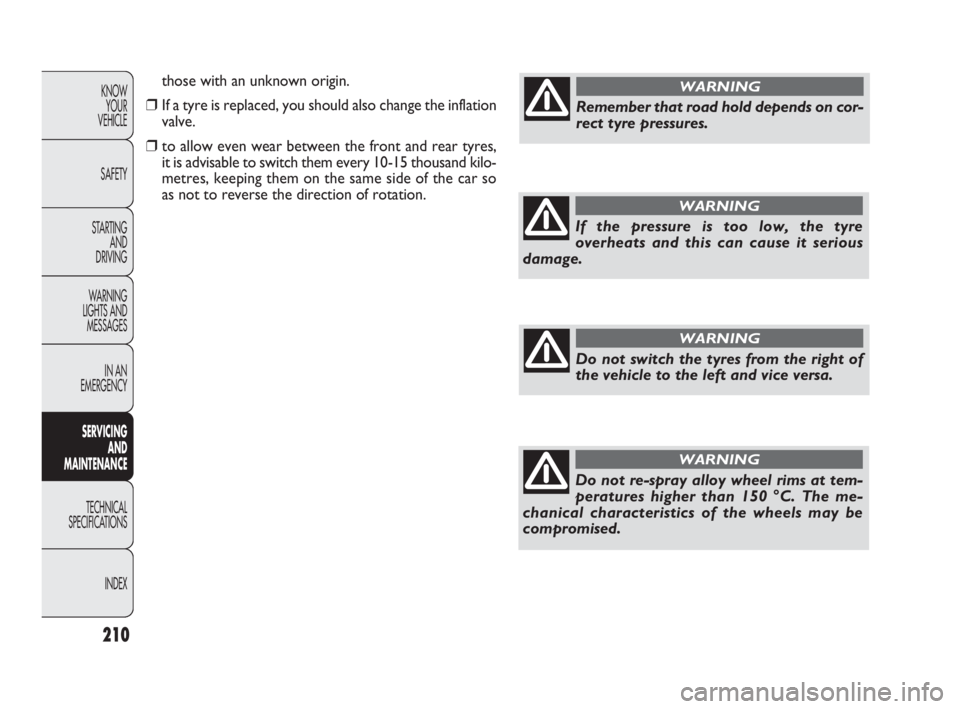
210
KNOW
YOUR
VEHICLE
SAFETY
STARTING
AND
DRIVING
WARNING
LIGHTS AND
MESSAGES
IN AN
EMERGENCY
SERVICING
AND
MAINTENANCE
TECHNICAL
SPECIFICATIONS
INDEX
those with an unknown origin.
❒If a tyre is replaced, you should also change the inflation
valve.
❒to allow even wear between the front and rear tyres,
it is advisable to switch them every 10-15 thousand kilo-
metres, keeping them on the same side of the car so
as not to reverse the direction of rotation.
Remember that road hold depends on cor-
rect tyre pressures.
WARNING
If the pressure is too low, the tyre
overheats and this can cause it serious
damage.
WARNING
Do not switch the tyres from the right of
the vehicle to the left and vice versa.
WARNING
Do not re-spray alloy wheel rims at tem-
peratures higher than 150 °C. The me-
chanical characteristics of the wheels may be
compromised.
WARNING
191-218 DOBLO LUM EN 2e 7.0 24-05-2010 10:40 Pagina 210
Page 215 of 274
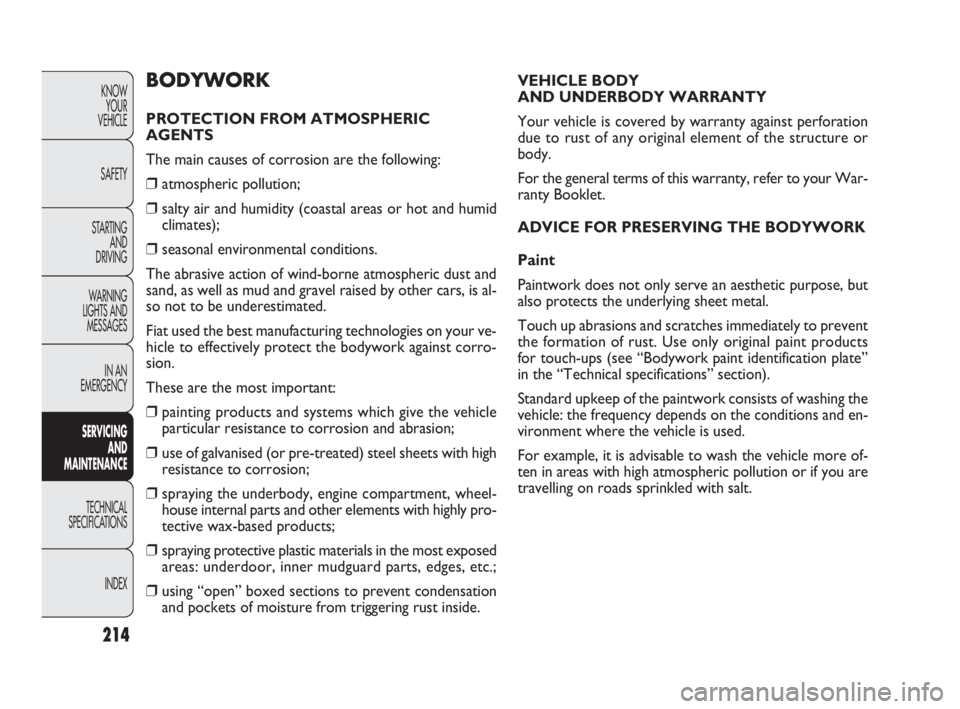
214
KNOW
YOUR
VEHICLE
SAFETY
STARTING
AND
DRIVING
WARNING
LIGHTS AND
MESSAGES
IN AN
EMERGENCY
SERVICING
AND
MAINTENANCE
TECHNICAL
SPECIFICATIONS
INDEX
VEHICLE BODY
AND UNDERBODY WARRANTY
Your vehicle is covered by warranty against perforation
due to rust of any original element of the structure or
body.
For the general terms of this warranty, refer to your War-
ranty Booklet.
ADVICE FOR PRESERVING THE BODYWORK
Paint
Paintwork does not only serve an aesthetic purpose, but
also protects the underlying sheet metal.
Touch up abrasions and scratches immediately to prevent
the formation of rust. Use only original paint products
for touch-ups (see “Bodywork paint identification plate”
in the “Technical specifications” section).
Standard upkeep of the paintwork consists of washing the
vehicle: the frequency depends on the conditions and en-
vironment where the vehicle is used.
For example, it is advisable to wash the vehicle more of-
ten in areas with high atmospheric pollution or if you are
travelling on roads sprinkled with salt.BODYWORK
PROTECTION FROM ATMOSPHERIC
AGENTS
The main causes of corrosion are the following:
❒atmospheric pollution;
❒salty air and humidity (coastal areas or hot and humid
climates);
❒seasonal environmental conditions.
The abrasive action of wind-borne atmospheric dust and
sand, as well as mud and gravel raised by other cars, is al-
so not to be underestimated.
Fiat used the best manufacturing technologies on your ve-
hicle to effectively protect the bodywork against corro-
sion.
These are the most important:
❒painting products and systems which give the vehicle
particular resistance to corrosion and abrasion;
❒use of galvanised (or pre-treated) steel sheets with high
resistance to corrosion;
❒spraying the underbody, engine compartment, wheel-
house internal parts and other elements with highly pro-
tective wax-based products;
❒spraying protective plastic materials in the most exposed
areas: underdoor, inner mudguard parts, edges, etc.;
❒using “open” boxed sections to prevent condensation
and pockets of moisture from triggering rust inside.
191-218 DOBLO LUM EN 2e 7.0 24-05-2010 10:41 Pagina 214
Page 217 of 274
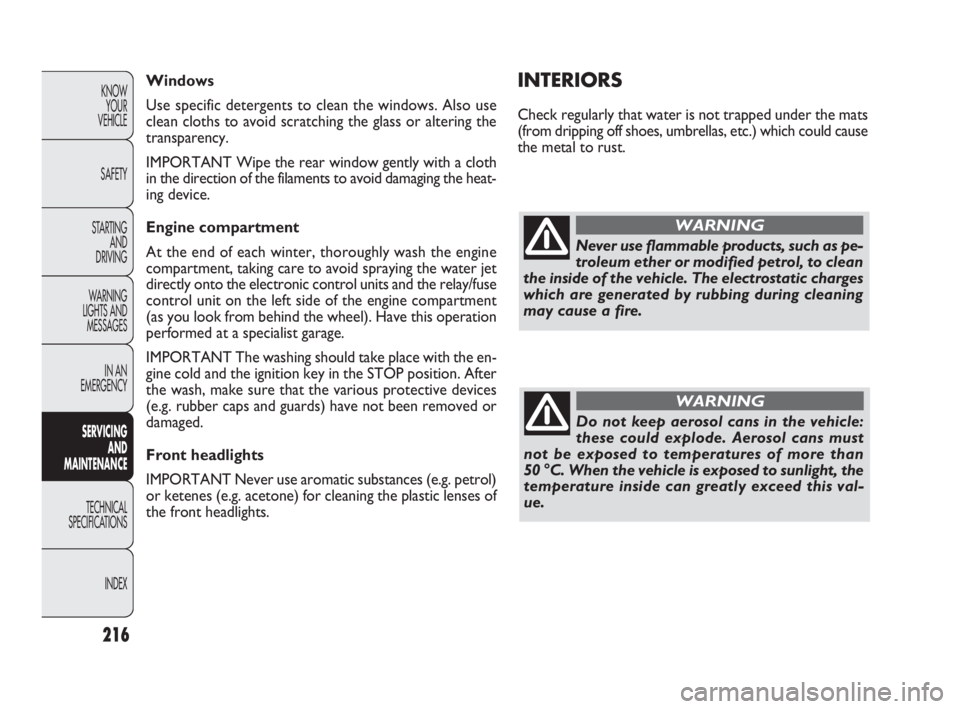
216
KNOW
YOUR
VEHICLE
SAFETY
STARTING
AND
DRIVING
WARNING
LIGHTS AND
MESSAGES
IN AN
EMERGENCY
SERVICING
AND
MAINTENANCE
TECHNICAL
SPECIFICATIONS
INDEX
INTERIORS
Check regularly that water is not trapped under the mats
(from dripping off shoes, umbrellas, etc.) which could cause
the metal to rust. Windows
Use specific detergents to clean the windows. Also use
clean cloths to avoid scratching the glass or altering the
transparency.
IMPORTANT Wipe the rear window gently with a cloth
in the direction of the filaments to avoid damaging the heat-
ing device.
Engine compartment
At the end of each winter, thoroughly wash the engine
compartment, taking care to avoid spraying the water jet
directly onto the electronic control units and the relay/fuse
control unit on the left side of the engine compartment
(as you look from behind the wheel). Have this operation
performed at a specialist garage.
IMPORTANT The washing should take place with the en-
gine cold and the ignition key in the STOP position. After
the wash, make sure that the various protective devices
(e.g. rubber caps and guards) have not been removed or
damaged.
Front headlights
IMPORTANT Never use aromatic substances (e.g. petrol)
or ketenes (e.g. acetone) for cleaning the plastic lenses of
the front headlights.
Never use flammable products, such as pe-
troleum ether or modified petrol, to clean
the inside of the vehicle. The electrostatic charges
which are generated by rubbing during cleaning
may cause a fire.
WARNING
Do not keep aerosol cans in the vehicle:
these could explode. Aerosol cans must
not be exposed to temperatures of more than
50 °C. When the vehicle is exposed to sunlight, the
temperature inside can greatly exceed this val-
ue.
WARNING
191-218 DOBLO LUM EN 2e 7.0 24-05-2010 10:41 Pagina 216
Page 218 of 274
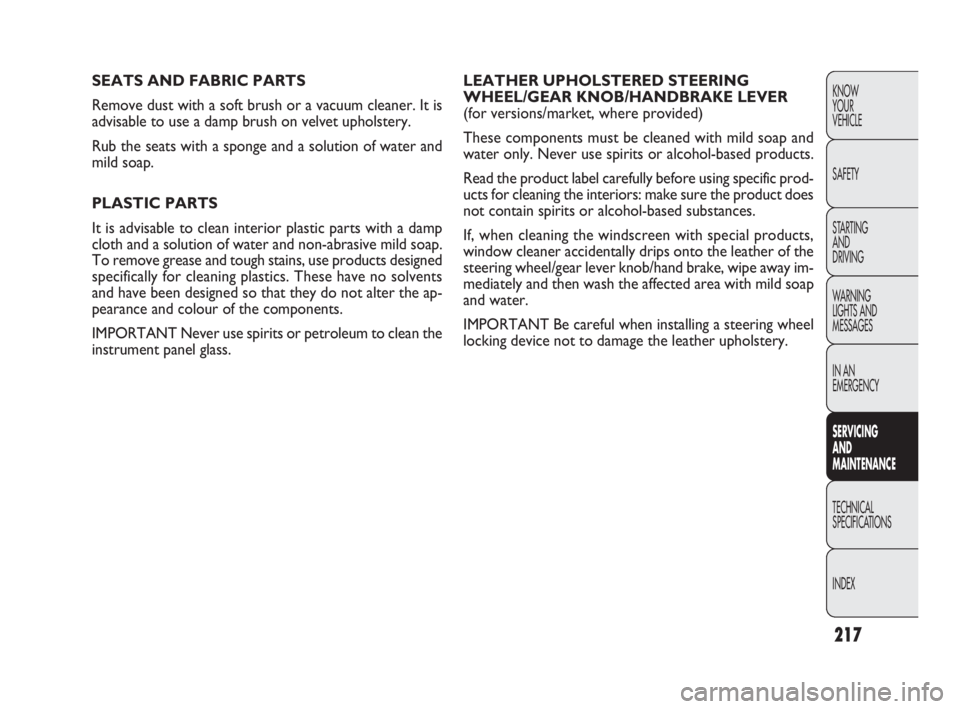
217
KNOW
YOUR
VEHICLE
SAFETY
STARTING
AND
DRIVING
WARNING
LIGHTS AND
MESSAGES
IN AN
EMERGENCY
SERVICING
AND
MAINTENANCE
TECHNICAL
SPECIFICATIONS
INDEX
LEATHER UPHOLSTERED STEERING
WHEEL/GEAR KNOB/HANDBRAKE LEVER
(for versions/market, where provided)
These components must be cleaned with mild soap and
water only. Never use spirits or alcohol-based products.
Read the product label carefully before using specific prod-
ucts for cleaning the interiors: make sure the product does
not contain spirits or alcohol-based substances.
If, when cleaning the windscreen with special products,
window cleaner accidentally drips onto the leather of the
steering wheel/gear lever knob/hand brake, wipe away im-
mediately and then wash the affected area with mild soap
and water.
IMPORTANT Be careful when installing a steering wheel
locking device not to damage the leather upholstery. SEATS AND FABRIC PARTS
Remove dust with a soft brush or a vacuum cleaner. It is
advisable to use a damp brush on velvet upholstery.
Rub the seats with a sponge and a solution of water and
mild soap.
PLASTIC PARTS
It is advisable to clean interior plastic parts with a damp
cloth and a solution of water and non-abrasive mild soap.
To remove grease and tough stains, use products designed
specifically for cleaning plastics. These have no solvents
and have been designed so that they do not alter the ap-
pearance and colour of the components.
IMPORTANT Never use spirits or petroleum to clean the
instrument panel glass.
191-218 DOBLO LUM EN 2e 7.0 24-05-2010 10:41 Pagina 217
Page 226 of 274
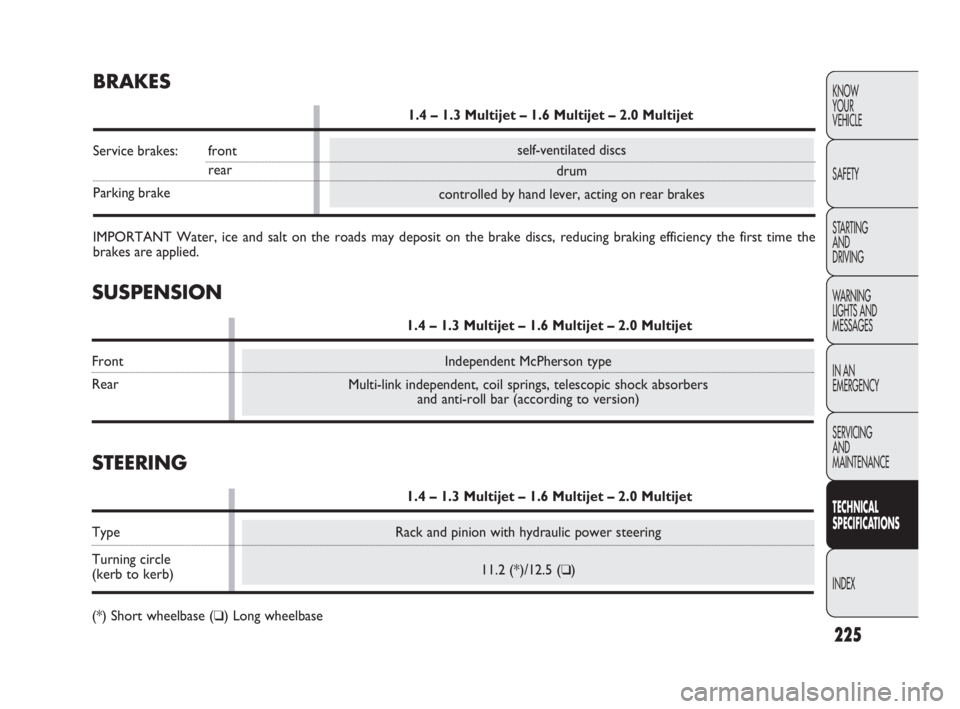
225
KNOW
YOUR
VEHICLE
SAFETY
STARTING
AND
DRIVING
WARNING
LIGHTS AND
MESSAGES
IN AN
EMERGENCY
SERVICING
AND
MAINTENANCE
TECHNICAL
SPECIFICATIONS
INDEX
Rack and pinion with hydraulic power steering
11.2 (*)/12.5 (
❑)
self-ventilated discs
drum
controlled by hand lever, acting on rear brakes
Independent McPherson type
Multi-link independent, coil springs, telescopic shock absorbers
and anti-roll bar (according to version)
BRAKES
1.4 – 1.3 Multijet – 1.6 Multijet – 2.0 Multijet
Service brakes: front
rear
Parking brake
IMPORTANT Water, ice and salt on the roads may deposit on the brake discs, reducing braking efficiency the first time the
brakes are applied.
SUSPENSION
1.4 – 1.3 Multijet – 1.6 Multijet – 2.0 Multijet
Front
Rear
STEERING
1.4 – 1.3 Multijet – 1.6 Multijet – 2.0 Multijet
Type
Turning circle
(kerb to kerb)
(*) Short wheelbase (
❑) Long wheelbase
219-260 DOBLO LUM EN 2e 7.0 27-05-2010 15:10 Pagina 225
Page 227 of 274
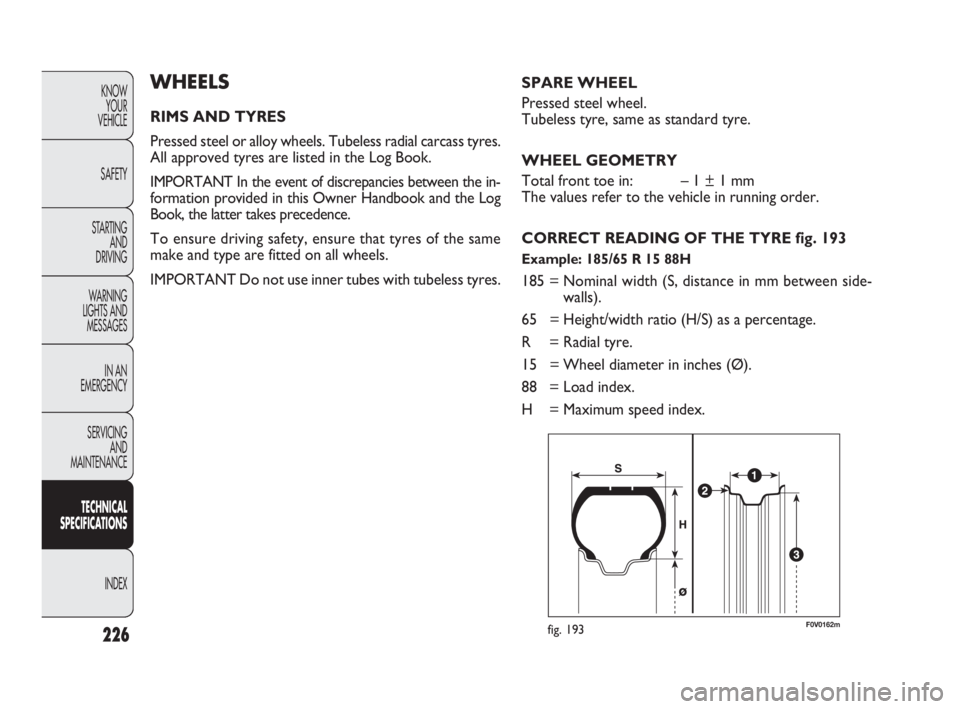
226
KNOW
YOUR
VEHICLE
SAFETY
STARTING
AND
DRIVING
WARNING
LIGHTS AND
MESSAGES
IN AN
EMERGENCY
SERVICING
AND
MAINTENANCE
TECHNICAL
SPECIFICATIONS
INDEX
WHEELS
RIMS AND TYRES
Pressed steel or alloy wheels. Tubeless radial carcass tyres.
All approved tyres are listed in the Log Book.
IMPORTANT In the event of discrepancies between the in-
formation provided in this Owner Handbook and the Log
Book, the latter takes precedence.
To ensure driving safety, ensure that tyres of the same
make and type are fitted on all wheels.
IMPORTANT Do not use inner tubes with tubeless tyres.
F0V0162mfig. 193
SPARE WHEEL
Pressed steel wheel.
Tubeless tyre, same as standard tyre.
WHEEL GEOMETRY
Total front toe in: – 1 ± 1 mm
The values refer to the vehicle in running order.
CORRECT READING OF THE TYRE fig. 193
Example: 185/65 R 15 88H
185 = Nominal width (S, distance in mm between side-
walls).
65 = Height/width ratio (H/S) as a percentage.
R = Radial tyre.
15 = Wheel diameter in inches (Ø).
88 = Load index.
H = Maximum speed index.
219-260 DOBLO LUM EN 2e 7.0 27-05-2010 15:10 Pagina 226
Page 228 of 274
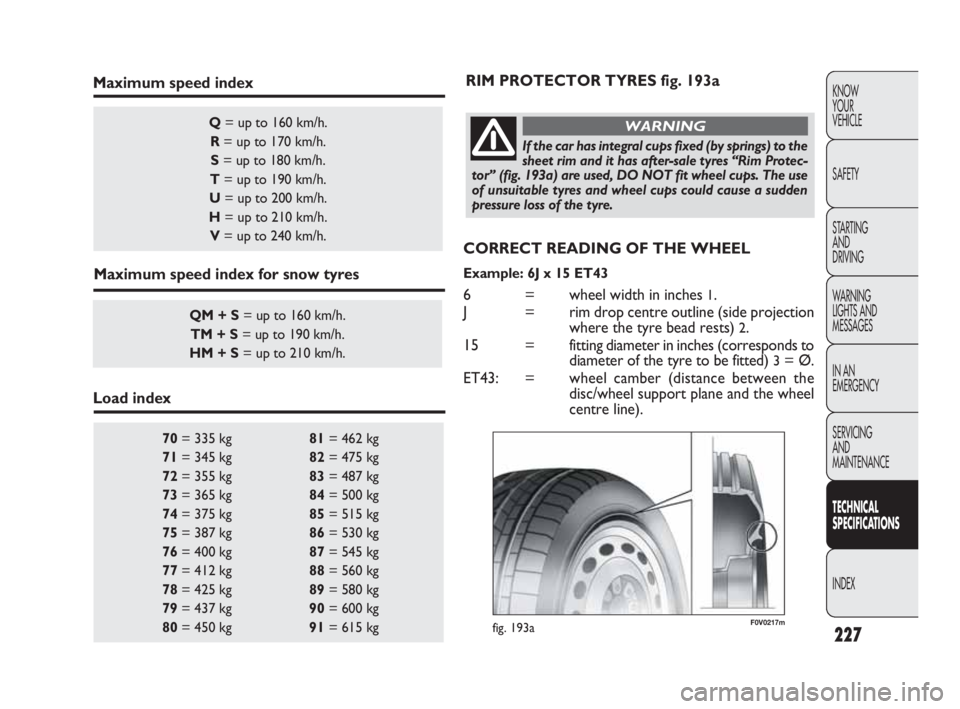
227
KNOW
YOUR
VEHICLE
SAFETY
STARTING
AND
DRIVING
WARNING
LIGHTS AND
MESSAGES
IN AN
EMERGENCY
SERVICING
AND
MAINTENANCE
TECHNICAL
SPECIFICATIONS
INDEX
70= 335 kg 81= 462 kg
71= 345 kg 82= 475 kg
72= 355 kg 83= 487 kg
73= 365 kg 84= 500 kg
74= 375 kg 85= 515 kg
75= 387 kg 86= 530 kg
76= 400 kg 87= 545 kg
77= 412 kg 88= 560 kg
78= 425 kg 89= 580 kg
79= 437 kg 90= 600 kg
80= 450 kg 91= 615 kg
Q= up to 160 km/h.
R= up to 170 km/h.
S= up to 180 km/h.
T= up to 190 km/h.
U= up to 200 km/h.
H= up to 210 km/h.
V= up to 240 km/h.
QM + S= up to 160 km/h.
TM + S= up to 190 km/h.
HM + S= up to 210 km/h.
Maximum speed index
Maximum speed index for snow tyres
Load indexRIM PROTECTOR TYRES fig. 193a
If the car has integral cups fixed (by springs) to the
sheet rim and it has after-sale tyres “Rim Protec-
tor” (fig. 193a) are used, DO NOT fit wheel cups. The use
of unsuitable tyres and wheel cups could cause a sudden
pressure loss of the tyre.
WARNING
F0V0217mfig. 193a
CORRECT READING OF THE WHEEL
Example: 6J x 15 ET43
6 = wheel width in inches 1.
J = rim drop centre outline (side projection
where the tyre bead rests)
2.
15 = fitting diameter in inches (corresponds to
diameter of the tyre to be fitted)
3= Ø.
ET43: = wheel camber (distance between the
disc/wheel support plane and the wheel
centre line).
219-260 DOBLO LUM EN 2e 7.0 27-05-2010 15:10 Pagina 227